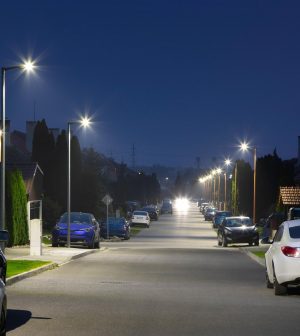- Navigating Your Midlife Crisis: Embracing New Possibilities
- City Raccoons Showing Signs of Domestication
- Mapping the Exposome: Science Broadens Focus to Environmental Disease Triggers
- One Week Less on Social Media Linked to Better Mental Health
- Your Brain Changes in Stages as You Age, Study Finds
- Some Suicide Victims Show No Typical Warning Signs, Study Finds
- ByHeart Formula Faces Lawsuits After Babies Sickened With Botulism
- Switch to Vegan Diet Could Cut Your Greenhouse Gas Emissions in Half
- Regular Bedtime Does Wonders for Blood Pressure
- Dining Alone Could Mean Worse Nutrition for Seniors
Could Bright Outdoor Lights at Night Raise Stroke Risk?

The bright lights of the big city might seem exciting, but they could also raise a person’s risk of stroke, a new study suggests.
Bright artificial lights that illuminate the night seem to affect blood flow to the brain in ways that make stroke more likely, researchers report.
People with the highest levels of exposure to outdoor light at night have a 43% increased risk of diseases affecting the blood vessels of the brain, results show.
These include clogged arteries that block the brain’s blood supply and bleeding into the brain, the two major causes of stroke.
Based on these results, “we advise people, especially those living in urban areas, to consider reducing that exposure to protect themselves from its potential harmful impact,” researcher Jian-Bing Wang with the Zhejiang University School of Medicine in Hangzhou, China, said in a news release.
Excessive use of artificial light has resulted in four-fifths of the world’s population living in light-polluted environments, researchers said in background notes.
For the study, Wang and colleagues analyzed data on more than 28,300 adults living in China, assessing their exposure to outdoor nighttime light using satellite images that mapped light pollution.
These adults lived in Ningbo, a major port and industrial city on China’s east coast with a population of more than 8.2 million.
During six years of follow-up from 2015 to 2021, the researchers found nearly 1,300 cases of brain blood vessel disease, including 777 strokes caused by blocked arteries and 133 strokes caused by bleeding into the brain.
The researchers noted that continuous exposure to bright light at night can suppress the production of melatonin, a hormone that promotes sleep.
Thus, the lights might be contributing to stroke risk by impairing good sleep, researchers said.
“We need to develop more effective policies and prevention strategies to reduce the burden of disease from environmental factors such as light as well as air pollution, particularly for people living in the most densely populated, polluted areas around the world,” Wang said.
The researchers also found that air pollution increased stroke risk.
People exposed to the highest levels of particulate pollution in the air – caused by burning fuel, dust or smoke – had a 41% to 50% increased risk of stroke compared to those least exposed.
Nitrogen oxide emissions from traffic and industrial power plants increased stroke risk by 31% in those who were most heavily exposed, researchers added.
The new study appears in the journal Stroke.
More information
The Cleveland Clinic has more on blood vessel diseases of the brain.
SOURCE: American Heart Association, news release, March 25, 2024
Source: HealthDay
Copyright © 2025 HealthDay. All rights reserved.










